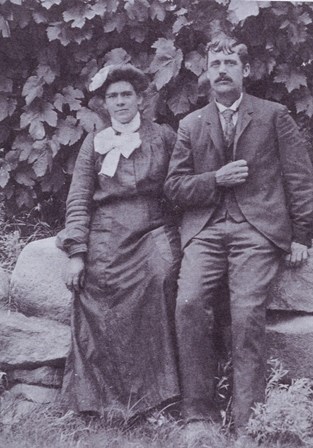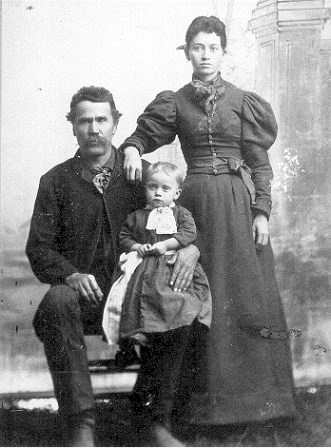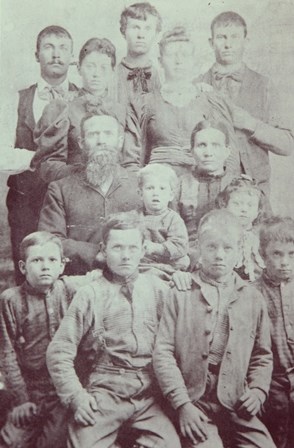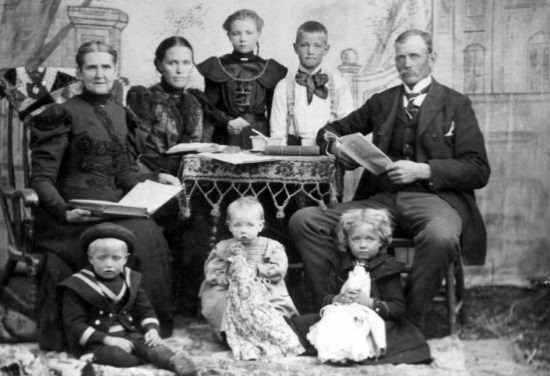Last updated: August 20, 2020
Article
Pioneer Women of Capitol Reef
Throughout the human history of Capitol Reef National Park, women have played a role.
Native people have utilized this area for thousands of years, and continue to have ties to the park. From approximately 300 to 1300 CE, the Fremont Culture (Hisatsinom - people who lived long ago), lived in what is now Capitol Reef National Park and the surrounding areas. Men likely hunted and brought home game while the women tended the farms, made clothing and tools, and tended to the next generation. Without the whole community contributing, the Hisatsinom would not have been as successful and thrived for nearly 1,000 years. People who followed them include the Ute, Paiute, Navajo, and other native groups.
Ellen Powell Thompson explored alongside her husband and others as they mapped this area in 1871. Pioneer families started to arrive in the late 1800's, developing the community of Fruita. Later residents included artists, businesswomen, and National Park Service staff.

Rena Holt
Rena Holt and her husband were two of the first white settlers to come to Fruita, Utah (now in Capitol Reef National Park). In 1895, they were living in a boarded up tent when Rena gave birth to her first baby, a girl named Myrtle Ivy. Rena was 19 and her husband was 21 at the time. Sadly, Myrtle Ivy died from a scorpion sting after only three months. Rena went on to have seven healthy children, many of whom lived into their 90’s.
The Holts eventually built their home not too far from where the Petroglyph Panel is today. Rena worked as a midwife in the Fruita community and was known to be competent and reliable. She aided in at least 55 births without the help of a doctor. Rena would stay with the new mothers for the first ten days after the birth. She charged $10 for her services, but would often barter or accept produce in exchange for her work. Rena was also the head of Fruita’s Relief Society, the Mormon women’s aid and social organization.

Mary Jane Behunin Johnson Cooper
Mary Jane moved to Fruita with her family as a child. She was the oldest daughter among 13 children. When she was just 17 years old, she married Nels Johnson, a 42 year old Swedish immigrant who planted some of the first fruit trees in Fruita. A year later she gave birth to her first child, Betty Jane, who died at age 5. Mary Jane lost two more babies before having her son, Nels William. She was five months pregnant with a fifth child when her husband Nels drowned in the Fremont River during a flash flood. She gave birth to a healthy baby, Lilly May, a few months later.
Mary lived in Fruita for a year and a half with her two surviving children before she met a man named Charles Cooper in Torrey and married him. They were married for eight years. Mary gave birth to three more daughters: Mary Elizabeth, Ida Pearl, and Fern May. It was complications from the birth of Fern that killed Mary at the age of 35.

Nettie Behunin Noyes
Mary Jane’s sister, Nettie, was one of the oldest Behunin daughters (standing on the right in the photo). As a daughter, she was expected to do household chores, although she preferred outdoor work to indoor work and was known to be strong and the best of all her siblings at repairs. She was also known to be patient with younger children.
In 1890, when she was just 12 years old, she became Fruita’s first school teacher. She would teach classes outdoors to the younger children and was loved by her students. In 1896, the Fruita schoolhouse was built, and Nettie was still teaching. At some point, she attended teacher school in Monroe, UT, about 90 miles from Fruita, and earned her official teaching license. Nettie married Fred Noyes in 1897, and had their first child a year later. When she was 22, Fruita got an official Utah State curriculum and Nettie was still the teacher. Later on in life, Nettie became the postmistress of Torrey.

Thisbe Read Hanks
One of the first known white women to settle in the Waterpocket Fold was Thisbe Read Hanks. She was born in England in the 1840s. When Thisbe was 10 years old her family converted to Mormonism (Church of the Latter-Day Saints). Like many new converts, they decided to head west to Zion (or the territory of Utah) and emigrated from England all the way to Salt Lake City. They sold their home and their small bookstore and sailed across the Atlantic; upon arriving in the U.S. they took a train to Illinois, where they joined the Martin Handcart Company, a group of over 500 Mormon pioneers planning to make the journey west. They were pushing and pulling all of their belongings and supplies in handcarts, which were significantly cheaper than wagons with horses. Along the way, Thisbe lost her brother and was separated from her father - she, her sister, and her mother made most of the journey on their own. The company had left late in the season and encountered blizzards; hundreds of people died from exposure, starvation, and dysentery.
Ephraim Hanks was part of the dramatic rescue of the Martin Handcart Company which is how he met Thisbe. He was in his 30’s, Thisbe only 11 years-old. When Thisbe was 13, Ephraim expressed he was interested in marrying her. They courted for three years and were married when Thisbe was 16 years old, becoming his third wife.
For the next two decades Thisbe was constantly pregnant or nursing, raising children, cooking, gardening, cleaning, and sewing. The family stopped practicing plural marriage in the 1870s; Ephraim divorced his other two wives and legally married Thisbe, his youngest wife.
Brigham Young ordered the family to move south, in part of the colonization effort of Southern Utah. Ephraim was to set up an outpost down at Lee’s Ferry. After stopping in Central Utah to wait out the winter, they received news they were no longer needed at Lee’s Ferry. Ephraim then went south with two of the oldest boys to explore and see if there might be a suitable place for the family to settle. Ephraim and the older boys returned with stories of a majestic, tranquil place, with huge cliff walls and a pleasant creek. They would move there, to a place where no other white folks had settled. The journey was emotional for Thisbe- she was intimidated by the desert, the towering cliff walls, the true isolation and had never before seen a landscape like this one.
The family settled at Pleasant Creek, where they lived in a dugout for several years before they built a house and planted fruit orchards. They named the area Floral Ranch. At this point, Thisbe was in her 30’s and had given birth to 12 children, ten of whom had survived infancy. She told Ephraim that she no longer wanted to have children, and he respected that wish. She also decided to get a horse at that time, and she would ride all over, often herding cattle. Her son said she had never felt more free. Thisbe died at Pleasant Creek in 1903. Later, in the 1950s, another notable woman, Alice Knee worked and lived in Pleasant Creek.
